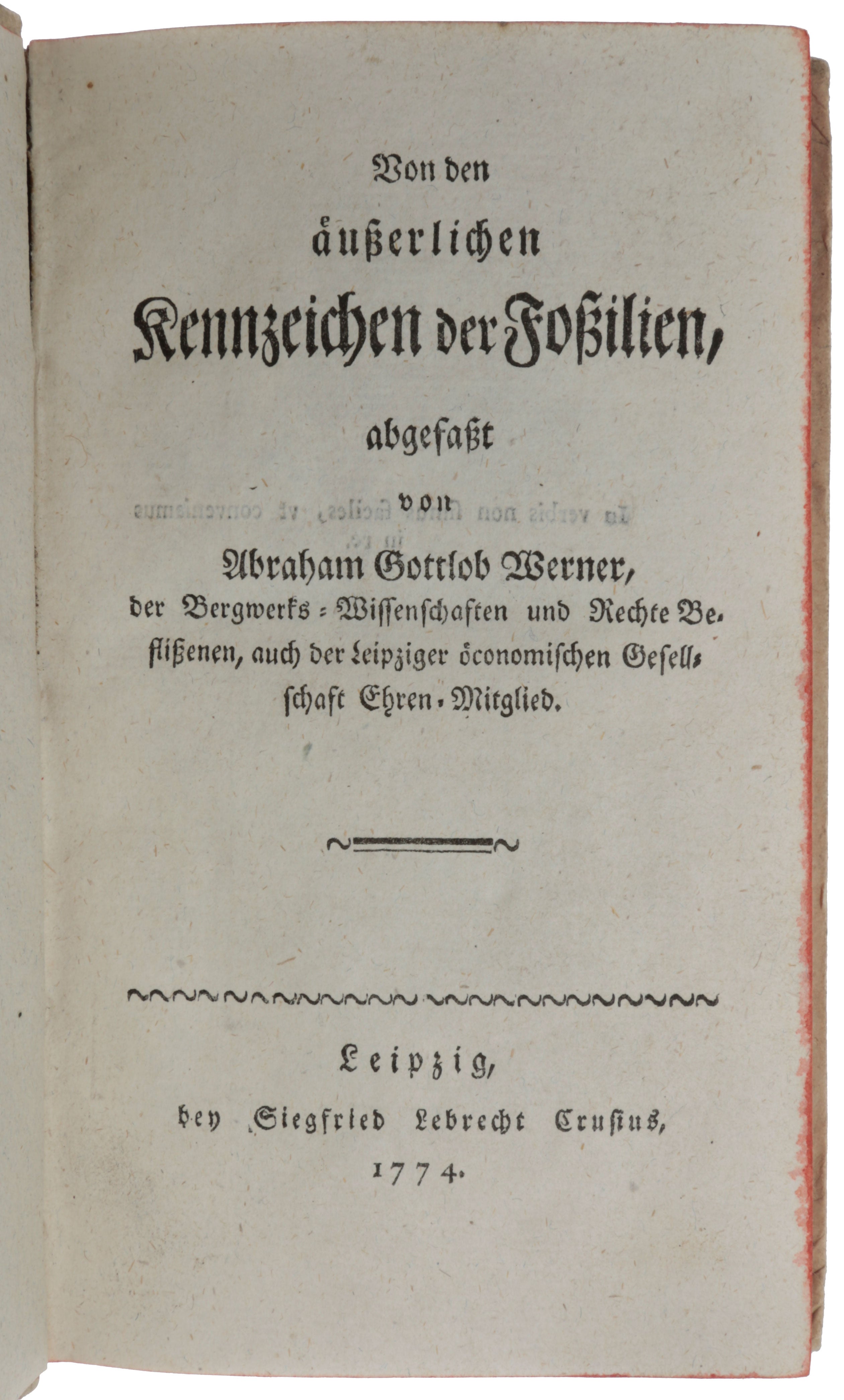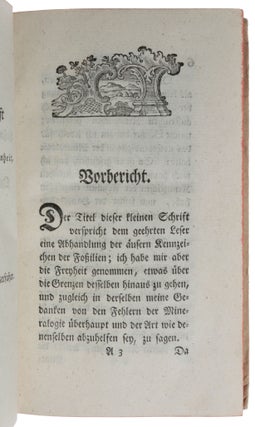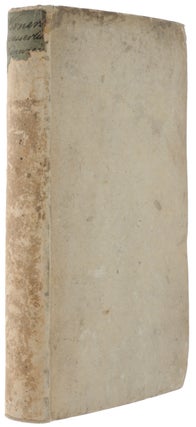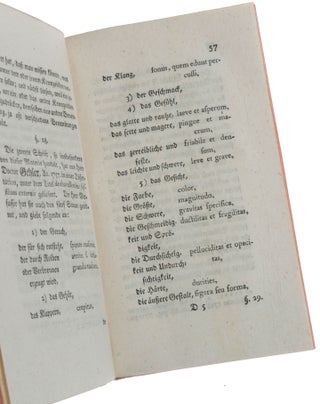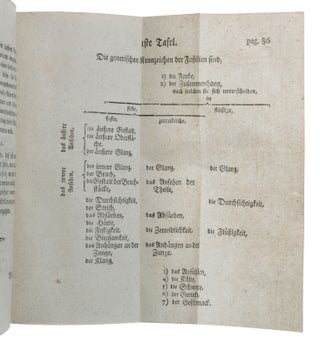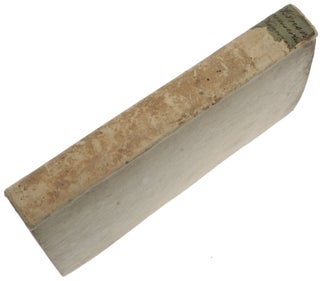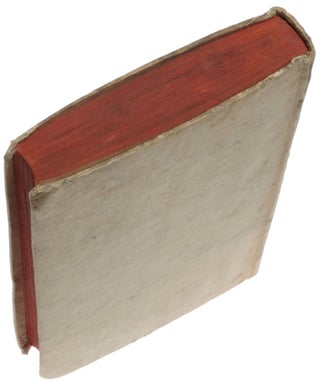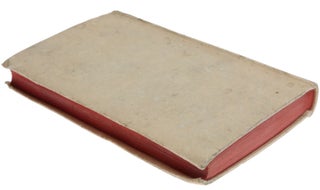Von den äusserlichen Kennzeichen der Fossilien.
Leipzig: Siegfried Lebrecht Crusius, 1774. First edition, rare, of Werner’s first published work and the first modern textbook of descriptive mineralogy (the ‘fossils’ in the title refer to anything removed from the ground). “Although Werner is best known for his contribution to the founding of geology as a science, he first achieved recognition as a mineralogist. He considered mineralogy to be the basis for all study of the earth, dividing it into five branches, of which geognosy (historical geology) was one and oryctognosy (descriptive mineralogy) another. And during all the years in which his theories on geognosy were arousing so much interest and controversy, he continued to work on his mineral system, the final version of which appeared after his death in 1817. His first important mineralogical work, however, Von den äusserlichen Kennzeichen der Fossilien, was not a mineral system but a classification of external characteristics of minerals, designed to aid the worker or the student in the field. In it Werner gave an unprecedented number of external characteristics with definitions, usually accompanied by homely examples which could be understood by both the layman and the natural philosopher. He also attempted to establish some standards of quantification and thus to clear away the vagueness in the terminology then in use. As chemistry and crystallography developed, mineralogists came to rely more on chemical analysis and less on external characteristics, but Von den äusserlichen Kennzeichen der Fossilien, published when Werner was twenty-five years old, continued to be an important work into the nineteenth century … Werner remained convinced of the importance of external characteristics, not only in the identification of minerals but also in the study of their composition. He reasoned that since the appearance of a mineral changes when its chemical composition is changed, there should be a correlation between chemical composition and external characteristics” (DSB). “Werner was the champion of a geological theory known as Neptunism, in which he believed that all minerals precipitated out of water. Neptunists were opposed to believers of Vulcanism, a theory that espoused the igneous origin of rocks” (Dibner) This book is “one of the most influential writings in the development of the mineralogical sciences. It is the first successful attempt at describing systematically determinative mineralogy. Werner who wrote this book, his first, as a student, at the youthful age of 24, had been around minerals and mining his entire life. He had practical experience in what was needed by the miners to identify minerals, and the reasons for identification. Werner had originally intended to publish an annotated translation of the dissertation written by Johann Carl Gehler titled: De Characterivs Fossilivm Externis (Lipsiæ, 1757). After showing the completed translation to his scientific circle, he was advised to that it was better to write a book that was wholly his own. The result was Von den äusserlichen Kennzeichen der Fossilien, which took the young Werner only a few months to complete. Based upon this book’s merits, Werner was appointed to the staff of the Freiberg Bergakademie, where he stayed the remainder of his professional life. “The book is written not as a mineralogical classification system as was then typical, but rather as a compendium of external characteristics of a large number of minerals. Werner intended it to be used as a practical guide for mineral identification, and proposed that this study be given the name ‘oryctognosy’ – a term previously applied in a wider sense, such as Bertrand’s Dictionnaire Oryctologique Universalle (Paris, 1763). For his book Werner precisely defined an unprecedented number of external characteristics that could be used to accurately identify specimens through hand examination. Included in the distinguishing features identified for use are color, luster, form, streak, hardness, and specific weight. Werner claimed that determining all of these qualities for a given mineral specimen was enough to identify its species. In fact, these same characters are readily found in modern handbooks of determinative mineralogy because in most cases they are enough to distinguish the common species. The landmark character of Werner’s work rests on the fact that no one before had so precisely defined the properties used to test minerals, and the effect on mineralogical science can be described as revolutionary, with many of his former students writing their own texts to spread Werner's theories in a multitude of other languages” (Schuh). “This book, in which Werner develops a completely new scientific description of minerals, is actually the first modern textbook on mineralogy. He was the first to recognize that a true and final classification of minerals should be based on their chemical composition and that it would be possible to identify the various minerals with certainty by their external characters and physical properties … Upon its publication in 1774, Von den äusserlichen Kennzeichen der Fossilien created an immense scientific interest all over Europe and inspired increased investigations in the particular field it had so brilliantly renovated, that is, the determination and classification of minerals according to external characters” (Carozzi, pp. 554-555). “Werner (1749-1817) was born into a family with a mining tradition; therefore, it was expected he should enter the profession. In 1774, as a student at the Freiberg Bergakademie, he wrote his first book, Von den äußerlichen Kennzeichen der Foßilien, and based upon its merit, in 1775, Werner was appointed professor of mineralogy at that institution. He remained there the rest of his professional life. He was by accounts an electrifying teacher, who devoted himself to developing the sciences of mineralogy and geology. His students, many of whom became famous instructors in there own right, spread his theories throughout Europe and North America. However, Werner’s idea that basalt was aqueous in origin sparked the great controversy between his theory and that of Scottish geologist James Hutton [1726-1797]. Werner accumulated an extensive personal mineral collection of over 10,000 specimens, which he sold for 40,000 talers to the Freiberg Bergakademie. Today, it is, together with Werner’s library, among the earliest of the great collections that still remains intact” (Schuh). Dibner, Heralds of Science 81; Norman 2205; Sparrow, Milestones of Science 196; Ward & Carozzi 2299. Carozzi, ‘A Study of Werner's Personal Copy of Von den äusserlichen Kennzeichen der Fossilien, 1774,’ Isis 51 (1960), pp. 554-557.
8vo (176 x 103 mm), pp. 302, [2], with 8 folding tables. Contemporary boards, a little frayed at head. A fine copy. Custom half leather clamshell box, gilt spine.
Item #5615
Price: $14,500.00

